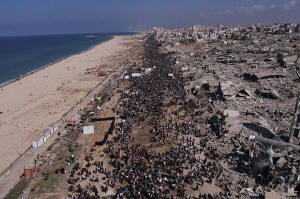Huge health challenges face Gaza residents returning to their homes
 Send a link to a friend
Send a link to a friend
 [January 28, 2025]
By TAMMY WEBBER [January 28, 2025]
By TAMMY WEBBER
Hospitals and clinics destroyed. Millions of tons of debris contaminated
with toxic substances, unexploded ordnance and human remains. Tens of
thousands of people with injuries that will require a lifetime of care.
As Gaza's residents return to what is left of their homes, they face new
risks on top of monumental health challenges. Fifteen months of war has
killed more than 47,000 people, according to local health officials,
displaced 90% of Gazans and reduced many areas to rubble. Clean water is
in short supply and sewers, so important for protecting public health,
are badly damaged spurring worries about the spread of infectious
disease.
Aid groups are rushing to provide food and supplies amid a fragile
ceasefire between Israel and Hamas as they plan the best way forward.
“You have a population with just every health need imaginable ... (who
have) been unable to get access to care ... for more than a year,” said
Yara Asi, an expert in global health management and visiting scholar at
the FXB Center of Health and Human Rights at Harvard. “What is that
going to look like in the near future and the long term ?”
Here’s a look at some of the urgent health issues.
Healthcare in shambles
Most of Gaza's 36 hospitals were damaged or partly destroyed by Israeli
bombs, with only half still partially operational, according to the
World Health Organization. Almost two-thirds of health clinics aren't
open. That makes it impossible to treat everyone who needs urgent and
long-term care — including an estimated 30,000 people who need ongoing
rehabilitation for “life-changing injuries,” such as amputations.
The WHO said that when it's safe, it'll team up with other organizations
to prioritize critical services such as trauma and emergency care,
primary health care and mental health support.

That includes increasing hospital-bed capacity in northern and southern
Gaza, and bringing in prefabricated containers to help treat patients at
damaged hospitals and clinics, the WHO said.
International workers also are needed to ease staffing shortages, the
organization said.
Asi and other experts said most hospital equipment has been destroyed,
and is expensive and difficult to import.
“How are Palestinians going to import the advanced, expensive medical
equipment that actually makes the hospital more than a building?” Asi
said. “That’s going to take years.”
Israel says Hamas is responsible for damage to the health system because
the group often used hospitals to hide or gather its men. Under the
current six-week ceasefire, Israel has allowed sharp increases of
humanitarian supplies. But the sides have not agreed on a permanent end
to the war, and Israel has not publicly laid out a postwar vision that
would include plans for reconstruction and cleanup of the territory.
Life-changing injuries
The WHO said one-fourth of the estimated 110,000 people injured in the
fighting suffered “life-changing” injuries, including over 12,000 who
need to be evacuated as soon as possible for specialized care.
Among the injured are thousands of children who lost limbs and will need
prosthetics and long-term care, said Marc Sinclair, a pediatric
orthopedic surgeon from Dubai who has volunteered in Gaza for over a
decade.
He said the charity he helped start, Little Wings Foundation, will
partner with the Palestinian Children's Relief Fund and a German
prosthetics company that will supply containers that can be turned into
workshops.
They hope to begin training doctors and manufacturing prosthetics in the
West Bank and move the operation to Gaza when they are able.
[to top of second column]
|

Displaced Palestinians return to their homes in the northern Gaza
Strip on Monday, Jan. 27, 2025, following Israel's decision to allow
thousands of them to go back for the first time since the early
weeks of the 15-month war with Hamas. (AP Photo/Mohammad Abu Samra)
 “The volume of injured is so huge
that it’s going to be an enormous task to fulfill the needs,"
Sinclair said. “We're talking about children that have not just
single amputations, but ... multiple amputations."
Asi, from Harvard, said thousands of people also suffered traumatic
injuries, including brain damage, that will require lifelong care.
"And then you have those people that have regular health ailments,”
she said. “They’ve been unable to get access to care or medications
in some cases for more than a year.”
Threat of infectious disease
A shortage of clean water, destroyed sanitation systems,
overcrowding and missed childhood vaccinations have created ideal
circumstances for spread of infectious disease, said Asi, also
co-director of the Palestine Program for Health and Human Rights.
She said children — many of whom experienced malnutrition and mental
trauma — are a special concern.
Gaza experienced a polio outbreak for the first time in decades, so
it is clear that both children and adults are at risk of other
infectious diseases, Asi said.
She said people have described crowded living conditions, a lack of
hygiene supplies and garbage and sewage in the streets.
“It’s really a health catastrophe from every potential facet," she
said, adding that there have been outbreaks of respiratory
infections in tent camps and shelters, and many people are living
with undiagnosed skin rashes and infections.
Dangerous debris
Experts say Palestinians returning to their homes in Gaza will be at
risk from breathing dust or touching debris contaminated with toxic
chemicals, asbestos and human remains, as well as munitions that
never exploded. On Monday, tens of thousands of people began
returning to northern Gaza as part of the ceasefire, finding piles
of rubble where their homes once stood.
It’s critical to move quickly to identify and contain environmental
hazards to “prevent returning residents from inadvertently coming
into contact with harmful pollutants” and to keep it from spreading,
a United Nations Environment Programme spokesperson said.
The agency plans to begin an on-the-ground assessment within two to
three months, as security allows.
The first priority should be for specialized teams to search for and
clear unexploded ordnance, then to test air, water and soil for
toxic substances, said Paul Walker, chair of the Chemical Weapons
Convention Coalition and a former staff member of the House Armed
Services Committee.

“People are anxious, I know, to rebuild,” he said, but returning
home right now “could be very dangerous ... I think we've got to
expect as people work through the rubble there will inevitably be
injuries and deaths.”
But it might be difficult to convince residents to delay their
return, said Asi. She said she's seen videos showing caravans of
people walking “in some cases knowing that there’s nothing waiting
for them but just wanting to go back to the land to recover the
bodies of loved ones or to see if their house survived or what
survives from their home.”
All contents © copyright 2025 Associated Press. All rights reserved |